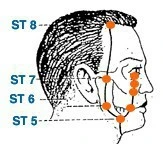Bell's Palsy Study Confirms Acupoint Sensitivity - An analysis of Sham vs. "Real" Points
Acupuncture is both a science and an art form and it doesn't always lend itself well to the controlled linear ways of western clinical trials. While there are volumes of positive studies with acupuncture, a smaller number of those include acupuncture how it is actually practiced (see "What does acupuncture treat? - for more on treating symptoms vs. root causes). There are even a few studies using "sham" needling which at times make it appear that they work as well as controlled diagnostically appropriate needling. The body is a mysterious, dynamic system that has an immense capacity for healing when prompted. It is not that strange that at times with no stimulation whatsoever the body will heal and even less strange than that that any modality, even improperly performed, could get results from time to time.
Now all that said, there are differences between practitioners and skill, intent and clinical experience will generally lead to better outcomes for patients. An experienced practitioner may be able to treat something that others couldn't and/or they may get a result in less time with less treatments than others would. There are very few studies exploring this dynamic, but it has been explored through the lineage traditions of Chinese Medicine by what we information and techniques we preserve and what ones we throw out.
 The study I'm going to discuss today was interesting in a few ways. First, I will describe the study. Researchers in this study used human patients with Bell's palsy (all on the left side) and divided them into three groups. All groups used electroacupuncture at one of three points - LI 4, ST 6 and a sham point. They then used fMRI studies to see what areas of the brain were affected and what the difference was between the points.
The study I'm going to discuss today was interesting in a few ways. First, I will describe the study. Researchers in this study used human patients with Bell's palsy (all on the left side) and divided them into three groups. All groups used electroacupuncture at one of three points - LI 4, ST 6 and a sham point. They then used fMRI studies to see what areas of the brain were affected and what the difference was between the points.
This study is good in my opinion because they are using patients with existing conditions to track what the points are doing. All too often these studies appear to be done on healthy populations. This is a problem because in Chinese Medicine - everyone - has a diagnostic pattern. This means that while you are treating no "known" existing disease, the underlying causal conditions are there and are different from person to person. Thus for a medicine that will acclimate and work with the body instead of dictating a certain direction you will, be default, get somewhat different results. By using patients with similar existing conditions you are not removing this possibility, but you are limiting the role in your results.
The researchers found significant differences between "real" and "sham" acupuncture points on this study. They also found that there was quite a bit of overlap of activity between LI 4 and ST 6 (local and distal points). This would make sense in our understanding of these acupuncture point functions:
Large Intestine (LI) 4: (distal point)
- Any
 problem on the face - sense organs, mouth, teeth, jaw, toothache, allergies, rhinitis, hay fever, acne, eye problems, etc.
problem on the face - sense organs, mouth, teeth, jaw, toothache, allergies, rhinitis, hay fever, acne, eye problems, etc.
Stomach (ST) 6: (local point)
- Eliminate wind from the face - TMJ, toothache, Bell's palsy, twitching, facial pain/paralysis.
As an aside, in case you got to this article looking for bell's palsy treatment... These points alone would not be a primary treatment for bell's palsy - those points are on our acupuncture for bell's palsy page.
tag @yinyanghouse for questions/comments